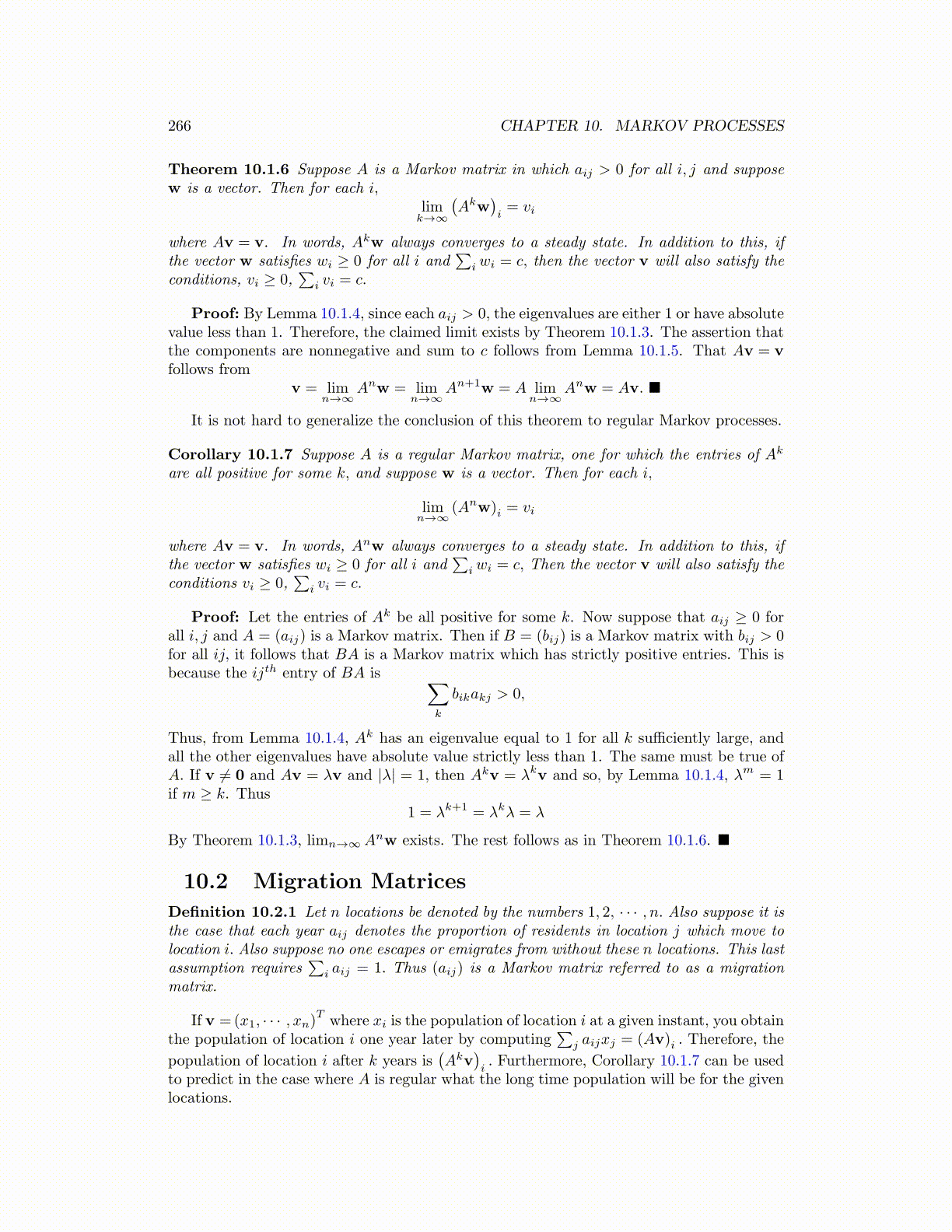
266 CHAPTER 10. MARKOV PROCESSES
Theorem 10.1.6 Suppose A is a Markov matrix in which aij > 0 for all i, j and supposew is a vector. Then for each i,
limk→∞
(Akw
)i= vi
where Av = v. In words, Akw always converges to a steady state. In addition to this, ifthe vector w satisfies wi ≥ 0 for all i and
∑i wi = c, then the vector v will also satisfy the
conditions, vi ≥ 0,∑
i vi = c.
Proof: By Lemma 10.1.4, since each aij > 0, the eigenvalues are either 1 or have absolutevalue less than 1. Therefore, the claimed limit exists by Theorem 10.1.3. The assertion thatthe components are nonnegative and sum to c follows from Lemma 10.1.5. That Av = vfollows from
v = limn→∞
Anw = limn→∞
An+1w = A limn→∞
Anw = Av. ■
It is not hard to generalize the conclusion of this theorem to regular Markov processes.
Corollary 10.1.7 Suppose A is a regular Markov matrix, one for which the entries of Ak
are all positive for some k, and suppose w is a vector. Then for each i,
limn→∞
(Anw)i = vi
where Av = v. In words, Anw always converges to a steady state. In addition to this, ifthe vector w satisfies wi ≥ 0 for all i and
∑i wi = c, Then the vector v will also satisfy the
conditions vi ≥ 0,∑
i vi = c.
Proof: Let the entries of Ak be all positive for some k. Now suppose that aij ≥ 0 forall i, j and A = (aij) is a Markov matrix. Then if B = (bij) is a Markov matrix with bij > 0for all ij, it follows that BA is a Markov matrix which has strictly positive entries. This isbecause the ijth entry of BA is ∑
k
bikakj > 0,
Thus, from Lemma 10.1.4, Ak has an eigenvalue equal to 1 for all k sufficiently large, andall the other eigenvalues have absolute value strictly less than 1. The same must be true ofA. If v ̸= 0 and Av = λv and |λ| = 1, then Akv = λkv and so, by Lemma 10.1.4, λm = 1if m ≥ k. Thus
1 = λk+1 = λkλ = λ
By Theorem 10.1.3, limn→∞Anw exists. The rest follows as in Theorem 10.1.6. ■
10.2 Migration Matrices
Definition 10.2.1 Let n locations be denoted by the numbers 1, 2, · · · , n. Also suppose it isthe case that each year aij denotes the proportion of residents in location j which move tolocation i. Also suppose no one escapes or emigrates from without these n locations. This lastassumption requires
∑i aij = 1. Thus (aij) is a Markov matrix referred to as a migration
matrix.
If v =(x1, · · · , xn)T where xi is the population of location i at a given instant, you obtainthe population of location i one year later by computing
∑j aijxj = (Av)i . Therefore, the
population of location i after k years is(Akv
)i. Furthermore, Corollary 10.1.7 can be used
to predict in the case where A is regular what the long time population will be for the givenlocations.